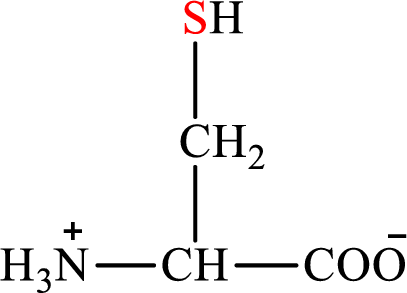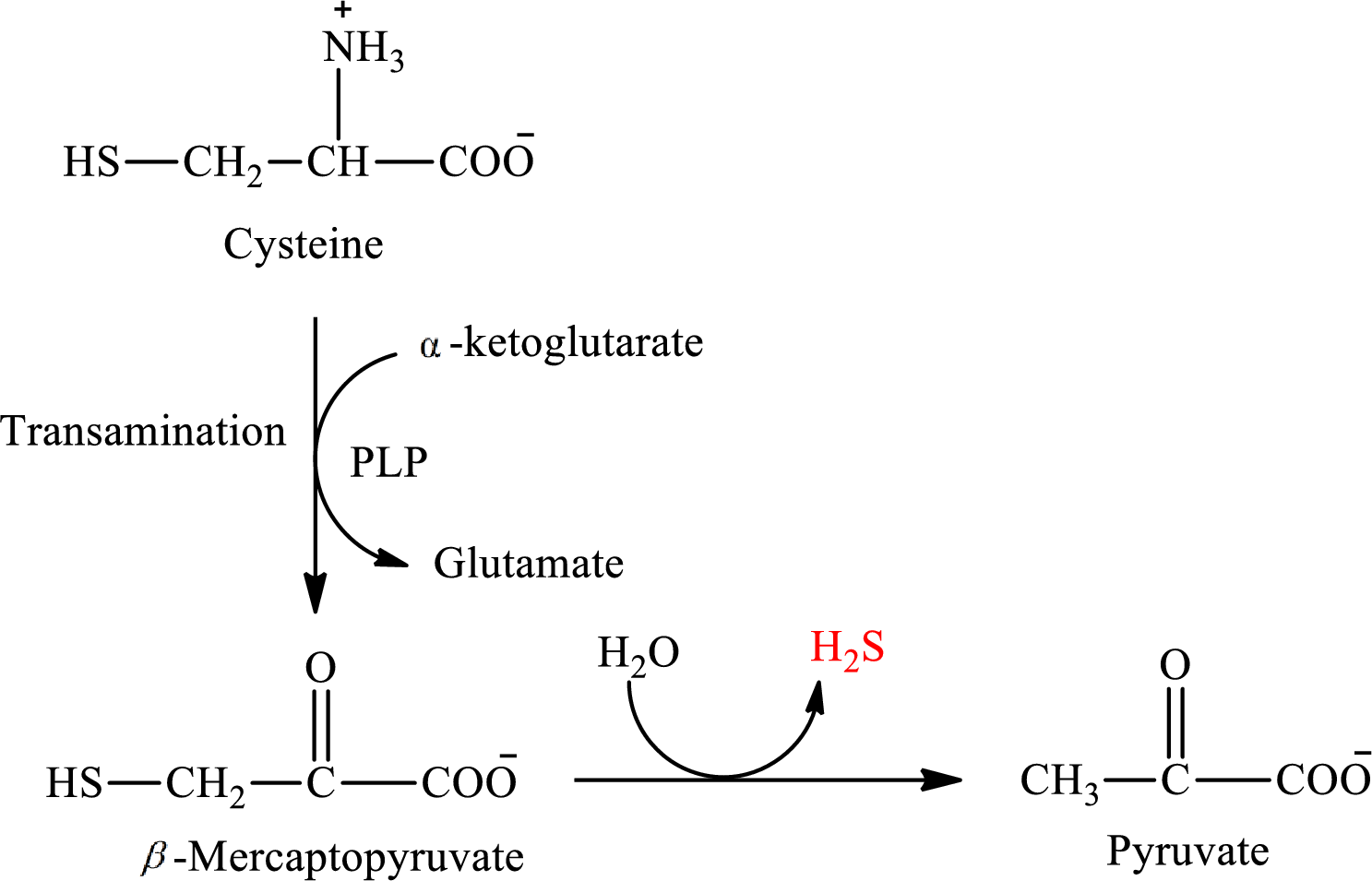
General, Organic, And Biological Chemistry, Hybrid (with Owlv2 Quick Prep For General Chemistry Printed Access Card)
7th Edition
ISBN: 9781305253070
Author: STOKER, H. Stephen
Publisher: Cengage Learning
expand_more
expand_more
format_list_bulleted
Concept explainers
Question
Chapter 26.8, Problem 4QQ
Interpretation Introduction
Interpretation: To identify a nonmetabolic function for hydrogen sulfide.
Concept introduction: Cysteine is a nonessential amino acid and has a sulfur atom in its side chain. The structure of cysteine is:

In degradation of the sulfur-containing amino acid cysteine, the sulfur is released in the form of hydrogen sulfide. The degradation process of cysteine is as follows:

Expert Solution & Answer
Want to see the full answer?
Check out a sample textbook solution
Students have asked these similar questions
Lab Data
The distance entered is out of the expected range.
Check your calculations and conversion factors.
Verify your distance. Will the gas cloud be closer to the cotton ball with HCI or NH3?
Did you report your data to the correct number of significant figures?
- X
Experimental Set-up
HCI-NH3
NH3-HCI
Longer Tube
Time elapsed (min)
5 (exact)
5 (exact)
Distance between cotton balls (cm)
24.30
24.40
Distance to cloud (cm)
9.70
14.16
Distance traveled by HCI (cm)
9.70
9.80
Distance traveled by NH3 (cm)
14.60
14.50
Diffusion rate of HCI (cm/hr)
116
118
Diffusion rate of NH3 (cm/hr)
175.2
175.2
How to measure distance and calculate rate
For the titration of a divalent metal ion (M2+) with EDTA, the stoichiometry of the reaction is typically:
1:1 (one mole of EDTA per mole of metal ion)
2:1 (two moles of EDTA per mole of metal ion)
1:2 (one mole of EDTA per two moles of metal ion)
None of the above
Please help me solve this reaction.
Chapter 26 Solutions
General, Organic, And Biological Chemistry, Hybrid (with Owlv2 Quick Prep For General Chemistry Printed Access Card)
Ch. 26.1 - Which of the following statements about dietary...Ch. 26.1 - Dietary protein materials as they leave the...Ch. 26.1 - The inactive form of pepsin is converted to its...Ch. 26.1 - Which of the following is not a proteolytic...Ch. 26.2 - The dominant use for the amino acids of the amino...Ch. 26.2 - The most abundant amino acid in the amino acid...Ch. 26.2 - Prob. 3QQCh. 26.3 - Prob. 1QQCh. 26.3 - Prob. 2QQCh. 26.3 - The net effect of transamination is to collect the...
Ch. 26.3 - Prob. 4QQCh. 26.3 - Prob. 5QQCh. 26.3 - Most aminotransferases are specific for the keto...Ch. 26.4 - Which of the following statements concerning the...Ch. 26.4 - Prob. 2QQCh. 26.4 - The two fuels for the urea cycle are a. carbamoyl...Ch. 26.4 - Prob. 4QQCh. 26.4 - Prob. 5QQCh. 26.4 - Prob. 6QQCh. 26.5 - Which of the following statements concerning the...Ch. 26.5 - Prob. 2QQCh. 26.5 - Prob. 3QQCh. 26.5 - Prob. 4QQCh. 26.6 - Prob. 1QQCh. 26.6 - How many of the standard amino acids are...Ch. 26.6 - The simplest pathways for amino acid biosynthesis...Ch. 26.7 - Prob. 1QQCh. 26.7 - Which of the following statements concerning the...Ch. 26.7 - Prob. 3QQCh. 26.7 - In the degradation of heme, the iron atom present...Ch. 26.8 - In degradation of the sulfur-containing amino acid...Ch. 26.8 - Prob. 2QQCh. 26.8 - Prob. 3QQCh. 26.8 - Prob. 4QQCh. 26.9 - Prob. 1QQCh. 26.9 - Prob. 2QQCh. 26.9 - Prob. 3QQCh. 26.10 - Prob. 1QQCh. 26.10 - Prob. 2QQCh. 26.10 - Prob. 3QQCh. 26 - Prob. 26.1EPCh. 26 - Indicate whether each of the following aspects of...Ch. 26 - Indicate whether each of the following pairings of...Ch. 26 - Indicate whether each of the following pairings of...Ch. 26 - Indicate whether each of the following statements...Ch. 26 - Prob. 26.6EPCh. 26 - Prob. 26.7EPCh. 26 - Prob. 26.8EPCh. 26 - Prob. 26.9EPCh. 26 - Prob. 26.10EPCh. 26 - Prob. 26.11EPCh. 26 - Prob. 26.12EPCh. 26 - Prob. 26.13EPCh. 26 - Prob. 26.14EPCh. 26 - Indicate whether each of the following situations...Ch. 26 - Indicate whether each of the following situations...Ch. 26 - Prob. 26.17EPCh. 26 - Prob. 26.18EPCh. 26 - Prob. 26.19EPCh. 26 - Prob. 26.20EPCh. 26 - Prob. 26.21EPCh. 26 - Prob. 26.22EPCh. 26 - Prob. 26.23EPCh. 26 - Prob. 26.24EPCh. 26 - Prob. 26.25EPCh. 26 - Prob. 26.26EPCh. 26 - Prob. 26.27EPCh. 26 - Prob. 26.28EPCh. 26 - Prob. 26.29EPCh. 26 - Prob. 26.30EPCh. 26 - Prob. 26.31EPCh. 26 - Prob. 26.32EPCh. 26 - Prob. 26.33EPCh. 26 - Prob. 26.34EPCh. 26 - Prob. 26.35EPCh. 26 - Prob. 26.36EPCh. 26 - Prob. 26.37EPCh. 26 - Prob. 26.38EPCh. 26 - Prob. 26.39EPCh. 26 - Prob. 26.40EPCh. 26 - Prob. 26.41EPCh. 26 - Prob. 26.42EPCh. 26 - Prob. 26.43EPCh. 26 - Draw the structure of the -keto acid produced from...Ch. 26 - Prob. 26.45EPCh. 26 - Prob. 26.46EPCh. 26 - Prob. 26.47EPCh. 26 - Prob. 26.48EPCh. 26 - Prob. 26.49EPCh. 26 - Prob. 26.50EPCh. 26 - Prob. 26.51EPCh. 26 - Prob. 26.52EPCh. 26 - Prob. 26.53EPCh. 26 - Prob. 26.54EPCh. 26 - Prob. 26.55EPCh. 26 - Prob. 26.56EPCh. 26 - Prob. 26.57EPCh. 26 - Prob. 26.58EPCh. 26 - Prob. 26.59EPCh. 26 - Prob. 26.60EPCh. 26 - Prob. 26.61EPCh. 26 - Prob. 26.62EPCh. 26 - Prob. 26.63EPCh. 26 - Prob. 26.64EPCh. 26 - Prob. 26.65EPCh. 26 - Prob. 26.66EPCh. 26 - Prob. 26.67EPCh. 26 - Prob. 26.68EPCh. 26 - Prob. 26.69EPCh. 26 - Prob. 26.70EPCh. 26 - Prob. 26.71EPCh. 26 - Prob. 26.72EPCh. 26 - Prob. 26.73EPCh. 26 - Prob. 26.74EPCh. 26 - Prob. 26.75EPCh. 26 - Prob. 26.76EPCh. 26 - Prob. 26.77EPCh. 26 - Prob. 26.78EPCh. 26 - Prob. 26.79EPCh. 26 - Prob. 26.80EPCh. 26 - Prob. 26.81EPCh. 26 - Prob. 26.82EPCh. 26 - Prob. 26.83EPCh. 26 - Prob. 26.84EPCh. 26 - Prob. 26.85EPCh. 26 - Prob. 26.86EPCh. 26 - Prob. 26.87EPCh. 26 - Prob. 26.88EPCh. 26 - Prob. 26.89EPCh. 26 - Prob. 26.90EPCh. 26 - Prob. 26.91EPCh. 26 - Prob. 26.92EPCh. 26 - Prob. 26.93EPCh. 26 - Prob. 26.94EPCh. 26 - Prob. 26.95EPCh. 26 - Prob. 26.96EPCh. 26 - Prob. 26.97EPCh. 26 - Which bile pigment is responsible for the...Ch. 26 - Prob. 26.99EPCh. 26 - Prob. 26.100EPCh. 26 - Prob. 26.101EPCh. 26 - Prob. 26.102EPCh. 26 - Prob. 26.103EPCh. 26 - Prob. 26.104EPCh. 26 - Prob. 26.105EPCh. 26 - Prob. 26.106EPCh. 26 - Prob. 26.107EPCh. 26 - Prob. 26.108EPCh. 26 - Prob. 26.109EPCh. 26 - Prob. 26.110EPCh. 26 - Prob. 26.111EPCh. 26 - Prob. 26.112EPCh. 26 - Prob. 26.113EPCh. 26 - Prob. 26.114EPCh. 26 - Prob. 26.115EPCh. 26 - Prob. 26.116EP
Knowledge Booster
Learn more about
Need a deep-dive on the concept behind this application? Look no further. Learn more about this topic, chemistry and related others by exploring similar questions and additional content below.Similar questions
- Indicate the products obtained by mixing 2,2-dimethylpropanal with acetaldehyde and sodium ethoxide in ethanol.arrow_forwardSynthesize 2-Ethyl-3-methyloxirane from dimethyl(propyl)sulfonium iodide using the necessary organic or inorganic reagents. Draw the structures of the compounds.arrow_forwardSynthesize 2-Hydroxy-2-phenylacetonitrile from phenylmethanol using the necessary organic or inorganic reagents. Draw the structures of the compounds.arrow_forward
- Synthesize N-Methylcyclohexylamine from cyclohexanol using the necessary organic or inorganic reagents. Draw the structures of the compounds.arrow_forwardSynthesize N-Methylcyclohexylamine from cyclohexanol using the necessary organic or inorganic reagents. Draw the structures of the compounds.arrow_forwardIf possible, please provide the formula of the compound 3,3-dimethylbut-2-enal.arrow_forward
- Synthesize 1,4-dibromobenzene from acetanilide (N-phenylacetamide) using the necessary organic or inorganic reagents. Draw the structures of the compounds.arrow_forwardIndicate the products obtained by mixing (3-oxo-3-phenylpropyl)triphenylphosphonium bromide with sodium hydride.arrow_forwardWe mix N-ethyl-2-hexanamine with excess methyl iodide and followed by heating with aqueous Ag2O. Indicate the major products obtained.arrow_forward
- Indicate the products obtained by mixing acetophenone with iodine and NaOH.arrow_forwardIndicate the products obtained by mixing 2-Propanone and ethyllithium and performing a subsequent acid hydrolysis.arrow_forwardIndicate the products obtained if (E)-2-butenal and 3-oxo-butanenitrile are mixed with sodium ethoxide in ethanol.arrow_forward
arrow_back_ios
SEE MORE QUESTIONS
arrow_forward_ios
Recommended textbooks for you
 General, Organic, and Biological ChemistryChemistryISBN:9781285853918Author:H. Stephen StokerPublisher:Cengage Learning
General, Organic, and Biological ChemistryChemistryISBN:9781285853918Author:H. Stephen StokerPublisher:Cengage Learning Organic And Biological ChemistryChemistryISBN:9781305081079Author:STOKER, H. Stephen (howard Stephen)Publisher:Cengage Learning,
Organic And Biological ChemistryChemistryISBN:9781305081079Author:STOKER, H. Stephen (howard Stephen)Publisher:Cengage Learning,

General, Organic, and Biological Chemistry
Chemistry
ISBN:9781285853918
Author:H. Stephen Stoker
Publisher:Cengage Learning

Organic And Biological Chemistry
Chemistry
ISBN:9781305081079
Author:STOKER, H. Stephen (howard Stephen)
Publisher:Cengage Learning,